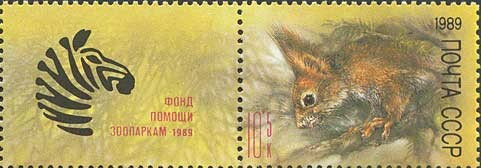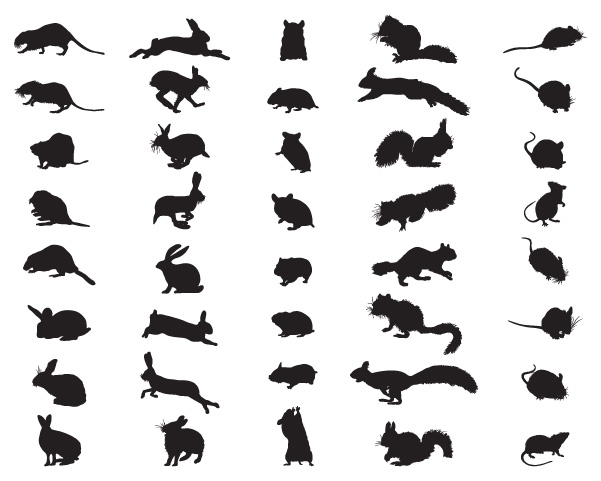Stamp with Attached Label: Eurasian Red Squirrel (Sciurus vulgaris) (Soviet Union, USSR 1989)
Eurasian Red Squirrel (Sciurus vulgaris) (Soviet Union, USSR 1989)
20 March (Soviet Union, USSR ) within release Zoo Relief Fund (1989) goes into circulation Stamp with Attached Label Eurasian Red Squirrel (Sciurus vulgaris) face value 10+5 Russian kopek
| Stamp with Attached Label Eurasian Red Squirrel (Sciurus vulgaris) in catalogues | |
|---|---|
| Michel: | Mi: SU 5936Zf |
Stamp with Attached Label is horizontal format.
Issued in sheets of 6 (2 x 3) se-tenant blocks of 6 stamps including 1 label. The surcharge was in aid of the Zoo Foundation.Also in the issue Zoo Relief Fund (1989):
- Stamp with Attached Label - Eurasian Red Squirrel (Sciurus vulgaris) face value 10+5;
- Stamp with Attached Label - European Pine Marten (Martes martes) face value 10+5;
- Stamp with Attached Label - West European Hedgehog (Erinaceus europaeus) face value 20+10;
Stamp with Attached Label Eurasian Red Squirrel (Sciurus vulgaris) it reflects the thematic directions:
Animals are multicellular, eukaryotic organisms of the kingdom Animalia (also called Metazoa). All animals are motile, meaning they can move spontaneously and independently, at some point in their lives. Their body plan eventually becomes fixed as they develop, although some undergo a process of metamorphosis later on in their lives. All animals are heterotrophs: they must ingest other organisms or their products for sustenance.
help, especially in the form of money, given freely to people who are in need, for example because they are ill, poor, or have no home, and organizations that provide this help: She does a lot of work for charity.
Mammals are any vertebrates within the class Mammalia (/məˈmeɪli.ə/ from Latin mamma "breast"), a clade of endothermic amniotes distinguished from reptiles (including birds) by the possession of a neocortex (a region of the brain), hair, three middle ear bones and mammary glands. All female mammals nurse their young with milk, secreted from the mammary glands. Mammals include the largest animals on the planet, the great whales. The basic body type is a terrestrial quadruped, but some mammals are adapted for life at sea, in the air, in trees, underground or on two legs. The largest group of mammals, the placentals, have a placenta, which enables the feeding of the fetus during gestation. Mammals range in size from the 30–40 mm (1.2–1.6 in) bumblebee bat to the 30-meter (98 ft) blue whale. With the exception of the five species of monotreme (egg-laying mammals), all modern mammals give birth to live young. Most mammals, including the six most species-rich orders, belong to the placental group. The largest orders are the rodents, bats and Soricomorpha (shrews and allies). The next three biggest orders, depending on the biological classification scheme used, are the Primates (apes and monkeys), the Cetartiodactyla (whales and even-toed ungulates), and the Carnivora (cats, dogs, seals, and allies).
Rodents (from Latin rodere, 'to gnaw') are mammals of the order Rodentia (/roʊˈdɛnʃə/ roh-DEN-shə), which are characterized by a single pair of continuously growing incisors in each of the upper and lower jaws. About 40% of all mammal species are rodents. They are native to all major land masses except for Antarctica, and several oceanic islands, though they have subsequently been introduced to most of these land masses by human activity.
Squirrels are members of the family Sciuridae a family that includes small or medium-sized rodents. The squirrel family includes tree squirrels, ground squirrels (including chipmunks and prairie dogs, among others), and flying squirrels. Squirrels are indigenous to the Americas, Eurasia, and Africa, and were introduced by humans to Australia. The earliest known fossilized squirrels date from the Eocene epoch, and among other living rodent families, the squirrels are most closely related to the mountain beaver and dormice





